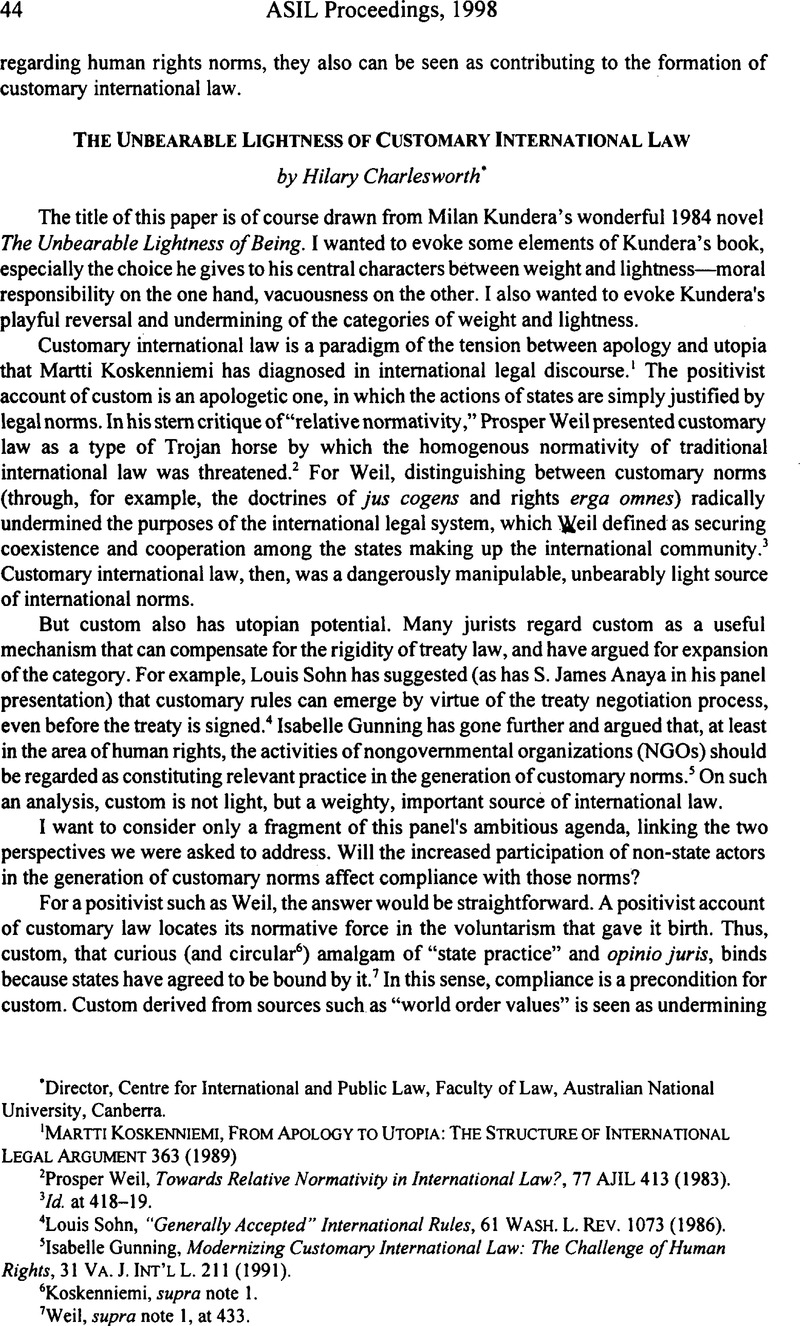Published online by Cambridge University Press: 28 February 2017

1 Martti Koskenniemi, From Apology to Utopia: The Structure of International Legal Argument 363 (1989)
2 Weil, Prosper, Towards Relative Normativity in International Law?, 77 AJIL 413 (1983)CrossRefGoogle Scholar.
3 Id. at 418-19.
4 Sohn, Louis, “Generally Accepted” International Rules, 61 Wash. L. Rev. 1073 (1986)Google Scholar.
5 Gunning, Isabelle, Modernizing Customary International Law: The Challenge of Human Rights, 31 Va. J. Int’l L. 211 (1991)Google Scholar.
6 Koskenniemi, supra note 1.
7 Weil, supra note 1, at 433.
8 See Briggs, Herbert W. et al., Appraisals of the Id’s Decision: Nicaragua v. United States (Merits), 81 AJIL 77 (1987)Google Scholar.
9 Id.
10 Abram Chayes & Antonia Handler Chayes, The New Sovereignty: Compliance with International Regulatory Agreements 25 (1995).
11 Thomas Franck, Fairness in International Law and Institutions (1995).
12 Koh, Harold, Review Essay: Why Do Nations Obey International Law?, 106 Yale L. J. 2599, 2603 (1997)CrossRefGoogle Scholar.
13 Tasioulas, John, In Defence of Relative Normativity: Communitarian Values and the Nicaragua Case , 16 Oxford J. Legal Stud. 85 (1996)CrossRefGoogle Scholar.
14 Id. at 117.
15 Tasioulas acknowledges this problem: Id. at 128.
16 Id.
17 See Otto, Dianne, Holding Up Half the Sky, But for Whose Benefit?: A Critical Analysis of the Fourth World Conference on Women, 6 Australian Feminist L. J. 7 (1996)CrossRefGoogle Scholar.
19 Christine Chinkin, The Future of Non-Governmental Organisations in the International Legal Order.
20 See e.g., Shearer, I., The Implications of Non-Treaty Law Making: Customary International Law and Its Implications, in Treaty-Making and Australia: Globalisation Versus Sovereignty 93 (Alston, P. & Chiam, M. eds., 1995)Google Scholar. Compare Wilets, J., Using International Law to Vindicate the Civil Rights of Gays and Lesbians in United States Courts, 27 Colum. Hum. Rts. L. Rev. 33, 52-53 (1995)Google Scholar (discussing the limitations of using arguments based on customary international law in U.S. courts).
20 Koh, supra note 10, at 2658.
21 Webber, Jeremy, Relations of Force and Relations of Justice: The Emergence of Normative Community between Colonists and Aboriginal Peoples, 33 Osgoode Hall L. J. 623 (1995)Google Scholar.
22 Id. at 627.
23 Id. at 628.
24 Id. at 656.